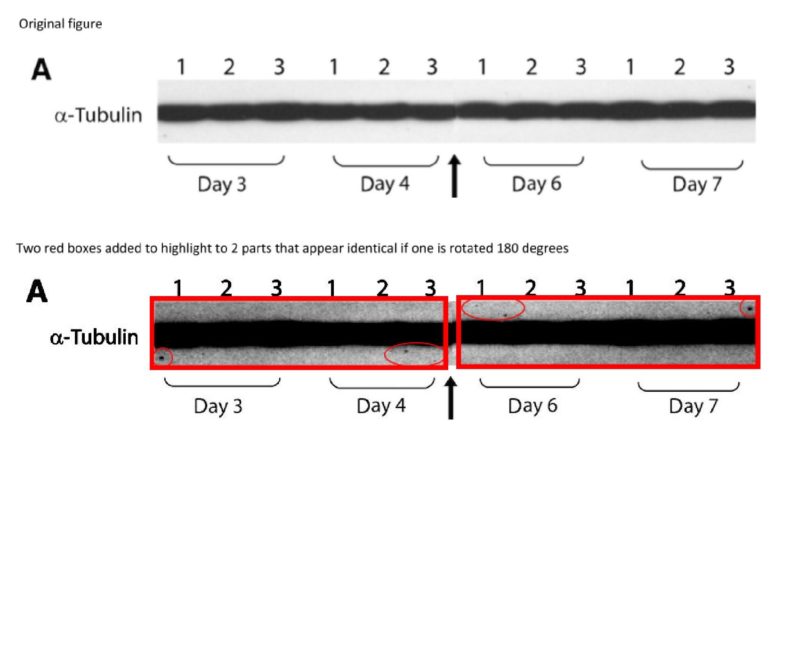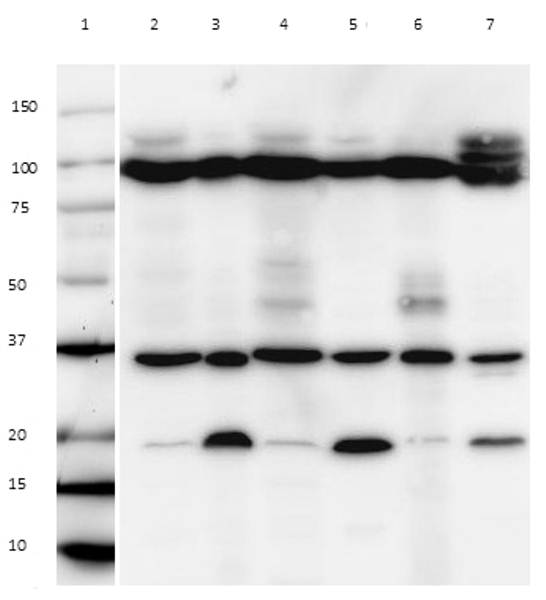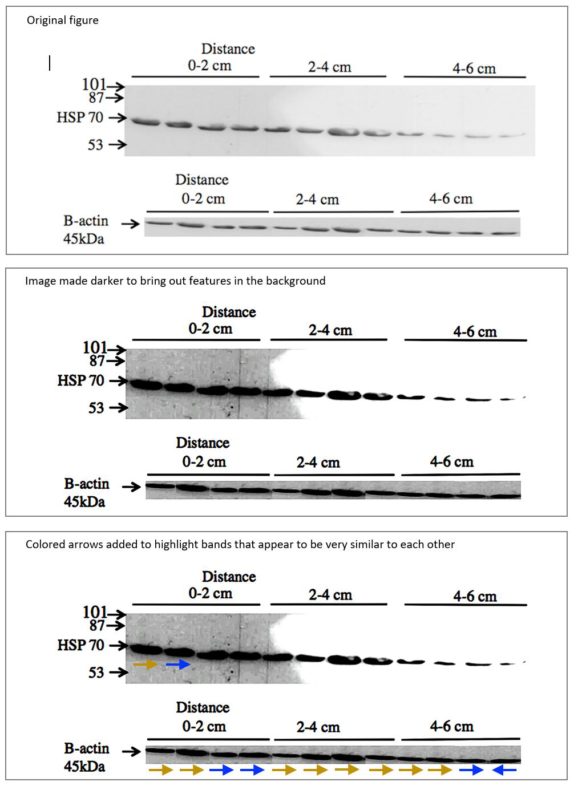
When you think of plagiarism, poems and books probably spring to mind more easily than, say, scientific papers. And words more easily than images. But plagiarism is not uncommon in science papers, and it often takes the form of images fiddled with and grafted from elsewhere. Whether they’re a consequence of laziness or a desire to mislead, these have played a role in the replication crisis many disciplines are now facing.
It’s a lot more difficult to detect plagiarism and fraud in scientific images than in written text. And even when you have irrefutable proof of wrongdoing, there are some surprising barriers to holding its authors to account. Nonetheless, some people are up to the task.
Meet Elisabeth Bik: by day, a mild-mannered director of science at a microbiome startup. By night (and on weekends), she takes to the internet and sifts through the scientific literature for the subtle visual fingerprints of misconduct. She has identified more than a thousand fraudulent images, and her work has led at least one journal to change the way it screens submissions. Her work has been featured several times by Retraction Watch, a blog that flays scientific malfeasance*.
Bik has contributed countless hours to keeping science honest, but most of them have been unpaid. Why would anyone commit so much of their own time to hunting down details that elude even paid gatekeepers? How does she do it? And does it do any good? I called her to find out.
The following interview has been edited for length and clarity
Sally: How did you start looking into plagiarised images in science papers?
Elisabeth Bik: I first got interested in plagiarism in science when I heard about people lifting text from other papers. Maybe I was naive, but I thought, scientists aren’t supposed to be capable of that! Perhaps out of idle curiosity, I just took a sentence from one of my own papers and put it into Google Scholar. I was so surprised – there it was in another paper.
Sally: You’re kidding! Which journal was it?
Elisabeth: Oh, it was one of these predatory journals so it wasn’t that important for science; these are not legitimate peer-reviewed publishers. But the experience stayed with me. And I became curious. I wanted to know if these problems were also occurring in more authoritative publications. When I started looking elsewhere, I found a great deal of plagiarism.
Anyway one day, I was going through another paper – someone’s thesis that was full of uncredited text – and I flipped past an image of a Western blot. I don’t know why it caught my eye.
Sally: What’s a Western blot?
Elisabeth: One of these.

A Western blot is an imaging technique used in molecular biology. It shows the presence or lack of proteins in biological tissue. In a paper, these are included to demonstrate that an experiment the researchers undertook had a specific effect.
In any case, I don’t know why this particular Western blot stayed with me – I think it contained a pretty memorable smudge. I kept going through the paper – and suddenly, there was the same image again. The same Western blot, the same smudge. Except it was rotated. And being used to illustrate a different experiment.
It had never occurred to me that this could be done. To be honest, it was so egregious that my faith in the noble profession of science was kind of shattered that day. How many other papers contained these kinds of altered or plagiarised images? Did this problem also exist in legitimate journals? So I looked at PLoS One.
Sally: Why PLoS One? They’re respectable!
Elisabeth: Right, that’s why I chose it. Legitimate scientists publish there, so you expect the papers to be legitimate. Also, PLoS makes it really easy to search their papers, so it seemed like a good place to start. So I began to search through every paper with the keyword word “Western blot”.
Sally: I’m sorry, I have to stop you again. Can I just ask – why would any scientist plagiarise someone else’s Western blot?
Elisabeth: So, people don’t plagiarise other people’s Western blots (as far as I know – I haven’t really looked into that yet). They plagiarise their own. You just copy and paste one experiment over and over.
Sally: Again – why?
Elisabeth: It saves time. The process of doing a Western blot is really time-consuming, but it is necessary to establish control conditions. Sometimes, I suppose, the scientist wants to take a short cut. So they simply reuse the image from the first control experiment and paste it wherever they need to show another one.
Sally: Okay, just to play devil’s advocate, is this really such a big deal?
Elisabeth: It’s a very big deal! Because now, how do I know you actually did a control experiment? The lack of a control casts doubt on the entire rest of the experiment.
Sally: Was this copy-pasting the only kind of image dishonesty you found in your investigations?
Elisabeth: Not at all. As I started going through more and more papers, I identified malfeasance that can be grouped into roughly three categories. The simple “copy and paste” was the least problematic, the easiest to spot and the most common. The second category describes that first Western blot I found – it’s the same picture, but now maybe a little bit shifted or rotated.
Sally: What’s the point of doing that?
Elisabeth: To make it a bit less obvious that you’ve copied and pasted. The third category is the most egregious – these images are not only copied, but also photoshopped.
Sally: So we’re not talking about a control experiment anymore.
Elisabeth: No. And it’s not just Western blots. I have found evidence of photoshopping in all kinds of microscopy images. You can use photoshop to make any claim you want.
Sally: Wow, that is brazen. So what can you do? These papers have already been published, right? What’s your next step?
Elisabeth: I get in touch with the journal’s editor. Sometimes, then, they launch an investigation. But it’s really up to them.
Sally: They don’t retract the paper automatically?!
Elisabeth: No. It’s a little bit of a grey area. When a journal asks an author about these things, most authors try to dismiss it. They might say they accidentally uploaded the wrong image. Or like, “we created a placeholder images and forgot to replace them with the real ones”. You know: the dog ate my homework.
The first category, sure, you might accept that as an explanation. The second category is a bit harder to swallow. The third is – there is just no excuse. However, it is up to the journal what they do with this information. Some of them decide, you know what, this no longer a valuable contribution to the scientific record. But what one journal will retract, another journal may just augment with a correction. There are no objective guidelines.
A hard lesson for me was that sometimes accuracy is not the first priority. There can be so many conflicts of interest. Sometimes an institution might not want to put pressure on an author who, let’s say, brings in a lot of money and prestige. This is what happened in Japan five years ago:
In 2014, RIKEN scientist Haruko Obokata published research claiming she had developed a surprisingly cheap and easy way to grow stem cells. The work, published in two papers in the journal Nature, seemed almost too good to be true. But after other scientists were unable to replicate it, some questions were raised about the data in the papers, including the images.
Elisabeth: People found manipulated images in both her papers. Nature ended up retracting them.
Sally: But you make it sound like that’s the exception rather than the rule. So when you have reported it – but there are conflicts of interest and no satisfactory response – what other options are available?
Elisabeth: The best way to do it is to write to the journal’s editor but as I mentioned, sometimes the journals and the institutions have other priorities.
To catch the serial offenders, there is another option: the images in Obokata’s paper were reported at a site called PubPeer. I’m not the only person looking out for these kinds of errors – on this site, if you have any questions about a paper or group, you can leave your comments, either under your full name or anonymously. It mainly exists as a repository for questionable images. Again, it’s not the best way to do it – the best way is to go directly to the journal.
Sally: But you also post some of the more jaw-dropping examples on your Twitter account.

Elisabeth: Sometimes I can’t help it. Especially when they are too ridiculous not to share. But I make sure I don’t link them to a specific journal or author.
Sally: Why not name and shame?
Elisabeth: I have to be a little bit worried about people coming after me. I have reported over a thousand cases, but it only takes one mad scientist with a gun to come find me online and come to my house.
I’m sure I’ve ruined people’s careers. And not just the scientists themselves. Anyone else on those papers with them: collaborators, students in their labs. After Haruko Obokata’s images and data were revealed to be fraudulent, her mentor committed suicide. These cases are really devastating for everybody involved. I very much realize that. But this is not a reason to look away and pretend you don’t see anything.
Sally: Has all this attention – from you and others – led to any improvements?
Elisabeth: Yes. My first paper with Arturo Casadevall and Ferric Fang was published in 2016; we also published two others in Science and Engineering Ethics in Molecular and Cellular Biology. We have developed guidance for journals to show them what they can do to reduce the number of these incidents.
Sally: Like what?
Elisabeth: Molecular and Cellular Biology has introduced an extra round of screening before they publish manuscripts, and I think more journals are realizing that that’s what they need to do. More and more journals are signing up to PubPeer to be notified after publication as well. I sometimes consult for journals to review papers for duplication and manipulation.
Sally: Is there software that can help?
Elisabeth: I do believe that will happen, but it hasn’t yet. I have given several groups in the DARPA Challenge access to my data set. Many have claimed that their software can find these things – but actually they have a lot of trouble finding a doctored image. I’ve met researchers all over the world who claim this problem could be easily fixed. It has not been fixed yet. So for now, it’s just people like me, comparing images manually.
Sally: You sometimes consult, but most of the work you do in this regard is unpaid. How much of your time do you spend hunting for doctored and reused images?
Elisabeth: Oh, it takes most of my time. I could probably do this 24 hours a day if I didn’t have a job. As it is, I spend between 10 and 20 hours of my weekend. [laughs] Very occasionally I still go to parties.
Sally: Why do you do it?
Elisabeth: I feel very strongly that science should be correct so that other people can build upon it. We should do everything we possibly can to make our work reproducible. And if people are manipulating or representing images of experiments that never happened, then we are misleading science.
What if someone wastes their entire career trying to base their research on falsified papers like this? Or worse – look at what falsified data did to vaccines in society. A whole committee concluded that most of Andrew Wakefield’s data were never recorded. But they took so long to investigate that, even though the paper was eventually retracted, the damage was done. Now there are many people who believe that vaccines cause autism.
I am frustrated that right now, cases just like this are still out there waiting to be investigated. It takes such a long time for official investigations to get under way.
Sally: Okay, so what would you say if somebody came along and said, listen, here’s a billion dollars. Go build a company, hire a bunch of people like you, and a bunch of software people, and go nuts.
Elisabeth: I would totally love to start that company. But until then, I’ll keep doing it in my spare time.
Sally: You know, in this era of grift, I find your commitment to this incredibly moving.
Elisabeth: That’s really nice to hear. Most people are not very happy with the work I do. There are people on my side of this – Ivan at Retraction Watch, the people on PubPeer. But mostly, it’s very lonely work.
Sally: I hope Elon Musk gives you a billion dollars.
You can follow Elisabeth Bik’s hunt for rotten images on Twitter at @MicrobiomDigest. She also runs the blog www.microbiomedigest.com.
Image Credits:
Category 2 Western blot: Elisabeth Bik.
Western blot example: Abcam
Category 3 Western blot with photoshopping: Elisabeth Bik
*Correction 13/02/19: The text has been updated to more accurately reflect the nature of Bik’s interaction with Retraction Watch.
Thank you, Elisabeth, for making science better.
Great interview about Elisabeth’s important work. Thank you.